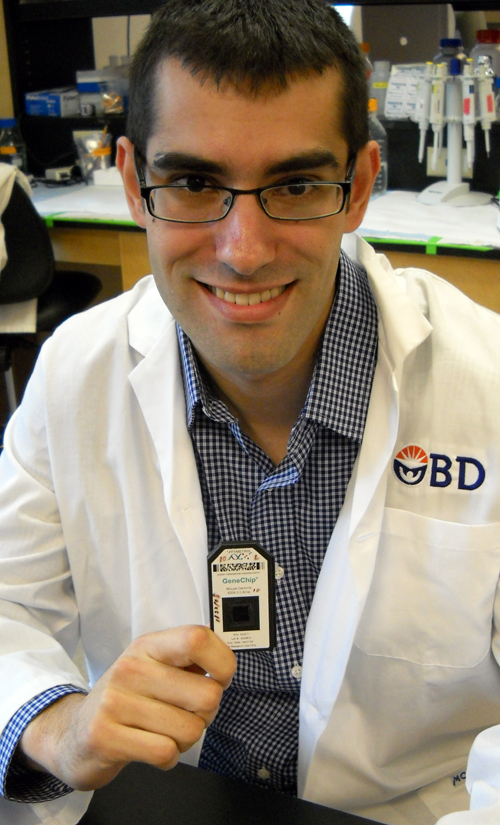
Moment to moment, your ticker keeps its lub-dub, lub-dub rhythm. But like other organs in your body, your heart also obeys a day-night cycle.
By hunting down heart genes controlled by circadian rhythms, or 24-hour cycles, biomedical sciences professor Tami Martino and her PhD student Peter Podobed hope to learn more about both healthy hearts and diseased ones.
Not only have they identified some of those clock-controlled genes, but they’ve also shown that one of them makes a protein central to keeping the heart beating. Their work could open the way to developing new drugs or treatments for heart patients and to exploring other clock genes that help keep the heart ticking.
Their most recent research was published in August in the journal PLOS One. Co-authors are Guelph PhD student Faisal Alibhai and Chi-Wing Chow, a researcher at the Albert Einstein College of Medicine in New York.
Besides its constant pumping, your heart contracts at different rates at various times of the day. That daily rhythm affects aspects of the cardiovascular system from blood pressure to timing of heart attacks.
Doctors already know that people with cardiovascular disease are more likely to suffer fatal heart attacks at certain times of the day than at others.
Hundreds of rhythmic genes are known to be involved in the day-night cycles of the cardiovascular system. Says Martino: “The heart is genetically a different organ day versus night.”
But which of those genes is directly regulated by the circadian clock mechanism in the heart?
Hoping to learn more, the Guelph researchers looked into public databases containing genetic information from mouse studies. Poring through that bioinformatics data, they looked for genes that showed diurnal rhythms and then for genes highly expressed in heart tissue.
They identified a number of heart genes that are regulated by circadian clocks. These genes are involved in making proteins needed to keep the heart beating properly.
One gene especially showed circadian rhythms in the production of a protein called Titin Cap (TCAP). This is the first protein in muscle filaments shown to be clock-controlled, says Podobed. “It’s exciting to see TCAP directly controlled by a clock mechanism.”
That protein is a key part of the heart’s sarcomeres, or the units of muscle fibres that enable contracting and flexing. TCAP helps to maintain the structure of the sarcomere and keep it working properly.
The researchers found that expression of the gene and amounts of the protein were rhythmic and peaked around the time of day that animals became most active.
That shows that the pertinent gene runs by the clock, says Prof. Glen Pyle, biomedical sciences. Along with Martino and other researchers in their department and in the College of Biological Science, he belongs to a heart research group at U of G.
Pyle studies sarcomere proteins including TCAP. Referring to his colleagues’ study, he says, “Their paper shows the protein changes at different times of day, likely when remodeling is occurring.”
The heart maintains itself at certain points each day. Suffering a heart attack during repair time “may be enough to push someone over the edge.”
He says this new study might help point doctors toward treatments such as viral or peptide therapy to be taken by heart patients at certain times. Studying heart clocks might also benefit people with disrupted diurnal rhythms, such as shift workers or long-distance travelers.
In other studies, Guelph researchers have shown that time of day determines the effectiveness of drugs for hypertension and congestive heart failure. Earlier this year, Martino published a paper showing that mice with heart attacks healed better under normal day and night cycles than those under disrupted routines.
Similar biological clocks run in organs throughout your body, all ultimately regulated by light and dark signals sent from the eye to the brain, says Podobed. “Circadian rhythms are important to many aspects of health and disease.”
He did his undergrad at the University of Toronto before coming to Guelph in 2009. Born in Russia, he claims good “scientist genes” of his own.
His mother, Olga Speranskaya, is an ecologist who won a 2011 United Nations environmental award for work intended to reduce the impact of toxic chemicals in Eastern Europe and Central Asia.
Olga’s mother, Anastasia Speranskaya, was a physicist and professor at Moscow State University. His father, Sergey Podobed, holds a PhD in theoretical physics from the Moscow Engineering and Physics Institute.
Peter Podobed’s maternal great-grandfather, Alexei Speransky, was a neuroscientist who worked at both the Soviet Academy of Sciences and the Soviet Academy of Medical Sciences.
Author of A Basis for the Theory of Medicine, Speransky was nominated twice in the 1930s for a Nobel Prize. He was a former student of Ivan Pavlov of “Pavlov’s dog” fame.
Podobed won several awards while at Guelph and aims to become a researcher. He defended his PhD thesis in August.